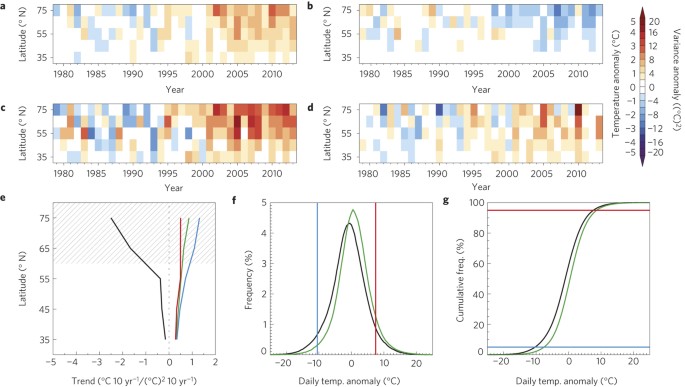Arctic amplification decreases temperature variance in northern mid- to high-latitudes
Arctic amplification decreases temperature variance in northern mid- to high-latitudes"
- Select a language for the TTS:
- UK English Female
- UK English Male
- US English Female
- US English Male
- Australian Female
- Australian Male
- Language selected: (auto detect) - EN
Play all audios:
Changes in climate variability are arguably more important for society and ecosystems than changes in mean climate, especially if they translate into altered extremes1,2,3. There is a common
perception and growing concern that human-induced climate change will lead to more volatile and extreme weather4. Certain types of extreme weather have increased in frequency and/or
severity5,6,7, in part because of a shift in mean climate but also because of changing variability1,2,3,8,9,10. In spite of mean climate warming, an ostensibly large number of high-impact
cold extremes have occurred in the Northern Hemisphere mid-latitudes over the past decade11. One explanation is that Arctic amplification—the greater warming of the Arctic compared with
lower latitudes12 associated with diminishing sea ice and snow cover—is altering the polar jet stream and increasing temperature variability13,14,15,16. This study shows, however, that
subseasonal cold-season temperature variability has significantly decreased over the mid- to high-latitude Northern Hemisphere in recent decades. This is partly because northerly winds and
associated cold days are warming more rapidly than southerly winds and warm days, and so Arctic amplification acts to reduce subseasonal temperature variance. Previous hypotheses linking
Arctic amplification to increased weather extremes invoke dynamical changes in atmospheric circulation11,13,14,15,16, which are hard to detect in present observations17,18 and highly
uncertain in the future19,20. In contrast, decreases in subseasonal cold-season temperature variability, in accordance with the mechanism proposed here, are detectable in the observational
record and are highly robust in twenty-first-century climate model simulations.
The ERA-Interim reanalysis was produced and provided by the European Centre for Medium-range Weather Forecasts; and the HadGHCND data set by the UK Met Office Hadley Centre. The author
acknowledges the World Climate Research Programme, which is responsible for the CMIP5 multi-model ensemble, and the modelling groups for producing and making available their model output. C.
Huntingford is thanked for commenting on an earlier version of the manuscript; and C. Deser and L. Sun for useful discussions. This research was financially supported by the UK Natural
Environment Research Council grant NE/J019585/1.
College of Engineering, Mathematics and Physical Sciences, University of Exeter, Exeter EX4 4QF, UK
Anyone you share the following link with will be able to read this content:
Trending News
An immunopathogenic perspective of interleukin-1 signalingAccess through your institution Buy or subscribe Interleukin-1 (IL-1), referred to as two distinct proteins, IL-1α and I...
Poster group 12 - technology and typing methodsAccess through your institution Buy or subscribe This is a preview of subscription content, access via your institution ...
Replacing: self | magazine | the harvard crimsonWith a click, I erased half of my memories. There was nothing else to do but wait. My 2019 MacBook Pro, scuffs and all, ...
Topological kerr effects in two-dimensional magnets with broken inversion symmetryABSTRACT The whorls of localized moments in chiral magnetic structures, such as skyrmions, lead to a quantized topologic...
The transformation of the dna template in rna polymerase ii transcription: a historical perspectiveABSTRACT The discovery of RNA polymerases I, II, and III opened up a new era in gene expression. Here I provide a person...
Latests News
Arctic amplification decreases temperature variance in northern mid- to high-latitudesChanges in climate variability are arguably more important for society and ecosystems than changes in mean climate, espe...
Yes, the unacknowledged factor that makes this circular is that asking me to prove a negative is… | by Alexander Kanellopoulos | MediumAlexander KanellopoulosFollow2 min read·Oct 19, 2021 --1ListenShareYes, the unacknowledged factor that makes this circul...
Synthesis and antibacterial activity of novel lincomycin derivatives. II. Exploring (7S)-7-(5-aryl-1,3,4-thiadiazol-2-yl-thio)-7-deoxylincomycin derivThe synthesis and antibacterial activity of (7S)-7-(5-aryl-1,3,4-thiadiazol-2-yl-thio)-7-deoxylincomycin derivatives are...
Startup definition: a co-founder’s perspectiveThese days the term startup is bandied around so loosely, it has almost started to grate on my ears. Anyone and everyone...
404 errorNew ranking shows ‘best campsites’ in France Could one of these 20 - as reviewed by camping users - be a great choice fo...
